Effects of O2 Plasma Treatments on the Photolithographic Patterning of PEDOT:PSS
Abstract
:1. Introduction
2. Materials and Methods
2.1. Materials and Procedure
2.2. Measurements
3. Results
3.1. Transferring an Image to the Photoresist and the Fragility of PEDOT:PSS Patterns
3.2. Traditional Process for PEDOT:PSS
3.3. Adding an O2 Plasma Treatment before Spin-Coating
3.4. Adding an O2 Plasma Treatment before Lifting Off the Photoresist
3.5. Combination of the Added O2 Plasma Treatments
4. Conclusions
Author Contributions
Funding
Institutional Review Board Statement
Informed Consent Statement
Data Availability Statement
Conflicts of Interest
References
- Zhang, X.-C.; Xu, J. Introduction to THz Wave Photonics; Springer: New York, NY, USA, 2010. [Google Scholar]
- Shi, J.-W.; Huang, C.-B.; Pan, C.-L. Millimeter-wave photonic wireless links for very high data rate communication. NPG Asia Mater. 2011, 3, 41–48. [Google Scholar] [CrossRef]
- Chen, C.-Y.; Hsieh, C.-F.; Lin, Y.-F.; Pan, R.-P.; Pan, C.-L. Magnetically tunable room-temperature 2π liquid crystal terahertz phase shifter. Opt. Express 2004, 12, 2625–2630. [Google Scholar] [CrossRef]
- Wu, H.-Y.; Hsieh, C.-F.; Tang, T.-T.; Pan, R.-P.; Pan, C.-L. Electrically tunable room-temperature 2π liquid crystal terahertz phase shifter. IEEE Photon. Technol. Lett. 2006, 18, 1488–1490. [Google Scholar] [CrossRef]
- Lin, X.-W.; Wu, J.-B.; Hu, W.; Zheng, Z.-G.; Wu, Z.-J.; Zhu, G.; Xu, F.; Jin, B.-B.; Lu, Y.-Q. Self-polarizing terahertz liquid crystal phase shifter. AIP Adv. 2011, 1, 032133. [Google Scholar] [CrossRef] [Green Version]
- Yang, C.-S.; Tang, T.-T.; Chen, P.-H.; Pan, R.-P.; Yu, P.; Pan, C.-L. Voltage-controlled liquid-crystal terahertz phase shifter with indium–tin–oxide nanowhiskers as transparent electrodes. Opt. Lett. 2014, 39, 2511. [Google Scholar] [CrossRef] [PubMed]
- Yang, C.-S.; Tang, T.-T.; Pan, R.-P.; Yu, P.; Pan, C.-L. Liquid crystal terahertz phase shifters with functional indium-tin-oxide nanostructures for biasing and alignment. Appl. Phys. Lett. 2014, 104, 141106. [Google Scholar] [CrossRef] [Green Version]
- Yang, C.-S.; Kuo, C.; Chen, P.-H.; Wu, W.-T.; Pan, R.-P.; Yu, P.; Pan, C.-L. High-transmittance 2π electrically tunable terahertz phase shifter with CMOS-compatible driving voltage enabled by liquid crystals. Appl. Sci. 2019, 9, 271. [Google Scholar] [CrossRef]
- Chiang, Y.-J.; Yang, C.-S.; Yang, Y.-H.; Pan, C.-L.; Yen, T.-J. An ultrabroad terahertz bandpass filter based on multiple-resonance excitation of a composite metamaterial. Appl. Phys. Lett. 2011, 99, 191909. [Google Scholar] [CrossRef] [Green Version]
- Chatzakis, I.; Tassin, P.; Luo, L.; Shen, N.-H.; Zhang, L.; Wang, J.; Koschny, T.; Soukoulis, C.M. One- and two-dimensional photo-imprinted diffraction gratings for manipulating terahertz waves. Appl. Phys. Lett. 2013, 103, 043101. [Google Scholar] [CrossRef] [Green Version]
- Hsieh, C.-F.; Lai, Y.-C.; Pan, R.-P.; Pan, C.-L. Polarizing terahertz waves with nematic liquid crystals. Opt. Lett. 2008, 33, 1174. [Google Scholar] [CrossRef] [Green Version]
- Sahoo, A.K.; Yang, C.-S.; Wada, O.; Pan, C.-L. Twisted nematic liquid crystal based terahertz phase shifter with crossed indium tin oxide finger type electrodes. IEEE Trans. Terahertz Sci. Technol. 2019, 9, 399–408. [Google Scholar] [CrossRef]
- Yang, C.-S.; Kuo, C.; Tang, C.-C.; Chen, J.C.; Pan, R.-P.; Pan, C.-L. Liquid-crystal terahertz quarter-wave plate using chemical-vapor-deposited graphene electrodes. IEEE Photon. J. 2015, 7, 2200808. [Google Scholar] [CrossRef]
- Kim, N.; Kee, S.; Lee, S.H.; Lee, B.H.; Kahng, Y.H.; Jo, Y.-R.; Kim, B.-J.; Lee, K. Highly conductive PEDOT:PSS nanofibrils induced by solution-processed crystallization. Adv. Mater. 2014, 26, 2268–2272. [Google Scholar] [CrossRef]
- Sun, K.; Zhang, S.; Li, P.; Xia, Y.; Zhang, X.; Du, D.; Isikgor, F.H.; Ouyang, J. Review on application of PEDOTs and PEDOT:PSS in energy conversion and storage devices. J. Mater. Sci. Mater. Electron. 2015, 26, 4438–4462. [Google Scholar] [CrossRef]
- Ouyang, S.; Xie, Y.; Wang, D.; Zhu, D.; Xu, X.; Tan, T.; Fong, H.H. Surface patterning of PEDOT:PSS by photolithography for organic electronic devices. J. Nanomater. 2015, 2015, 603148. [Google Scholar] [CrossRef] [Green Version]
- Sun, Y.; Yang, S.; Du, P.; Yan, F.; Qu, J.; Zhu, Z.; Zuo, J.; Zhang, C. Investigate the effects of EG doping PEDOT/PSS on transmission and anti-reflection properties using terahertz pulsed spectroscopy. Opt. Express 2017, 25, 1723. [Google Scholar] [CrossRef] [PubMed]
- Rwei, S.-P.; Lee, Y.-H.; Shiu, J.-W.; Sasikumar, R.; Shyr, U.-T. Characterization of solvent-treated PEDOT:PSS thin films with enhanced conductivities. Polymers 2019, 11, 134. [Google Scholar] [CrossRef] [Green Version]
- Huseynova, G.; Hyun Kim, Y.; Lee, J.-H.; Lee, J. Rising advancements in the application of PEDOT:PSS as a prosperous transparent and flexible electrode material for solution-processed organic electronics. J. Inf. Disp. 2020, 21, 71–91. [Google Scholar] [CrossRef] [Green Version]
- Ling, H.; Liu, S.; Zheng, Z.; Yan, F. Organic flexible electronics. Small Methods 2018, 2, 1800070. [Google Scholar] [CrossRef]
- Fan, X.; Nie, W.; Tsai, H.; Wang, N.; Huang, H.; Cheng, Y.; Wen, R.; Ma, L.; Yan, F.; Xia, Y. PEDOT:PSS for flexible and stretchable electronics: Modifications, strategies, and applications. Adv. Sci. 2019, 6, 1900813. [Google Scholar] [CrossRef] [Green Version]
- Hwang, H.S.; Zakhidov, A.A.; Lee, J.-K.; André, X.; Defranco, J.A.; Fong, H.H.; Holmes, A.B.; Malliaras, G.G.; Ober, C.K. Dry photolithographic patterning process for organic electronic devices using supercritical carbon dioxide as a solvent. J. Mater. Chem. 2008, 18, 3087–3090. [Google Scholar] [CrossRef]
- Lee, J.-K.; Taylor, P.G.; Zakhidov, A.A.; Fong, H.H.; Hwang, H.S.; Chatzichristidi, M.; Malliaras, G.G.; Ober, C.K. Orthogonal processing: A novel photolithographic patterning method for organic electronics. J. Photopolym. Sci. Technol. 2009, 22, 565–569. [Google Scholar] [CrossRef] [Green Version]
- Khong, S.-H.; Sivaramakrishnan, S.; Png, R.-Q.; Wong, L.-Y.; Chia, P.-J.; Chua, L.-L.; Ho, P.K.H. General photo-patterning of polyelectrolyte thin films via efficient ionic bis(fluorinated phenyl azide) photo-crosslinkers and their post-deposition modification. Adv. Funct. Mater. 2007, 17, 2490–2499. [Google Scholar] [CrossRef]
- Winroth, G.; Latini, G.; Credgington, D.; Wong, L.-Y.; Chua, L.-L.; Ho, P.K.-H.; Cacialli, F. Polyfluorene-based light-emitting diodes with an azide photocross-linked poly(3,4-ethylene dioxythiophene):(polystyrene sulfonic acid) hole-injecting layer. Appl. Phys. Lett. 2008, 92, 103308. [Google Scholar] [CrossRef]
- Fenwick, O.; Oliver, K.; Cacialli, F. Cross-linking of a poly(3,4-ethylene dioxythiophene):(polystyrene sulfonic acid) hole injection layer with a bis-azide salt and the effect of atmospheric processing conditions on device properties. Appl. Phys. Lett. 2012, 100, 053309. [Google Scholar] [CrossRef]
- Yoshida, S.; Hagiwara, K.; Hasebe, T.; Hotta, A. Surface modification of polymers by plasma treatments for the enhancement of biocompatibility and controlled drug release. Surf. Coatings Technol. 2013, 233, 99–107. [Google Scholar] [CrossRef]
- Håkansson, A.; Han, S.; Wang, S.; Lu, J.; Braun, S.; Fahlman, M.; Berggren, M.; Crispin, X.; Fabiano, S. Effect of (3-glycidyloxypropyl)trimethoxysilane (GOPS) on the electrical properties of PEDOT:PSS films. J. Polym. Sci. Part B Polym. Phys. 2017, 55, 814–820. [Google Scholar] [CrossRef] [Green Version]
- He, J.; Wan, Y.; Gao, P.; Tang, J.; Ye, J. Over 16.7% efficiency organic-silicon heterojunction solar cells with solution-processed dopant-free contacts for both polarities. Adv. Funct. Mater. 2018, 28, 1802192. [Google Scholar] [CrossRef]
- Chan, J.R.; Huang, X.Q.; Song, A.M. Nondestructive photolithography of conducting polymer structures. J. Appl. Phys. 2006, 99, 023710. [Google Scholar] [CrossRef] [Green Version]
- Athreya, S.; Venkatesh, Y.D. Application of Taguchi method for optimization of process parameters in improving the surface roughness of lathe facing operation. Int. Ref. J. Eng. Sci. 2012, 1, 13–19. [Google Scholar]
- Yoon, S.-S.; Khang, D.-Y. Roles of nonionic surfactant additives in PEDOT:PSS thin films. J. Phys. Chem. C 2016, 120, 29525–29532. [Google Scholar] [CrossRef]
- Wang, X.; Östblom, M.; Johansson, T.; Inganäs, O. PEDOT surface energy pattern controls fluorescent polymer deposition by dewetting. Thin Solid Films 2004, 449, 125–132. [Google Scholar] [CrossRef]
- Charlot, B.; Sassine, G.; Garraud, A.; Sorli, B.; Giani, A.; Combette, P. Micropatterning PEDOT:PSS layers. Microsyst. Technol. 2013, 19, 895–903. [Google Scholar] [CrossRef]
- Deegan, R.D.; Bakajin, O.; Dupont, T.F.; Huber, G.; Nagel, S.R.; Witten, T.A. Capillary flow as the cause of ring stains from dried liquid drops. Nature 1997, 389, 827–829. [Google Scholar] [CrossRef]
- Deegan, R.D.; Bakajin, O.; Dupont, T.F.; Huber, G.; Nagel, S.R.; Witten, T.A. Contact line deposits in an evaporating drop. Phys. Rev. E Stat. Phys. Plasmas Fluids Relat. Interdiscip. Top. 2000, 62, 756–765. [Google Scholar] [CrossRef] [PubMed] [Green Version]

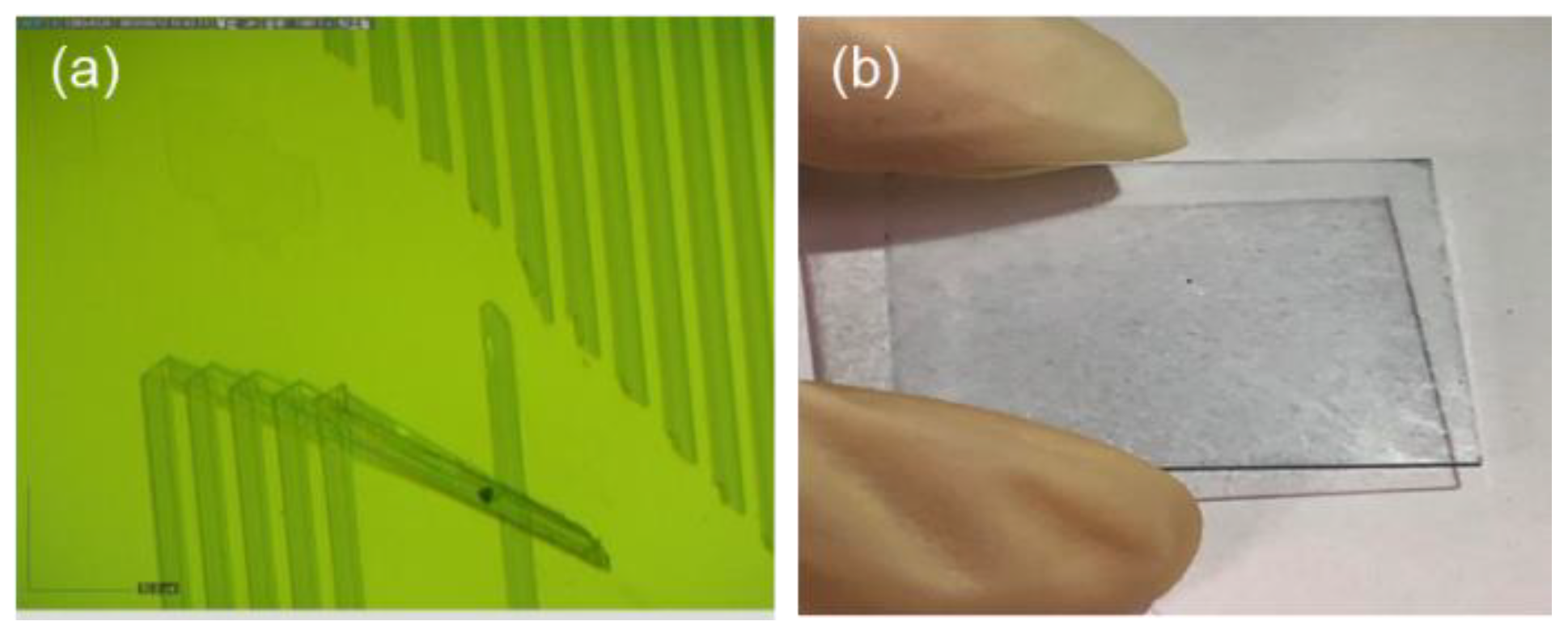
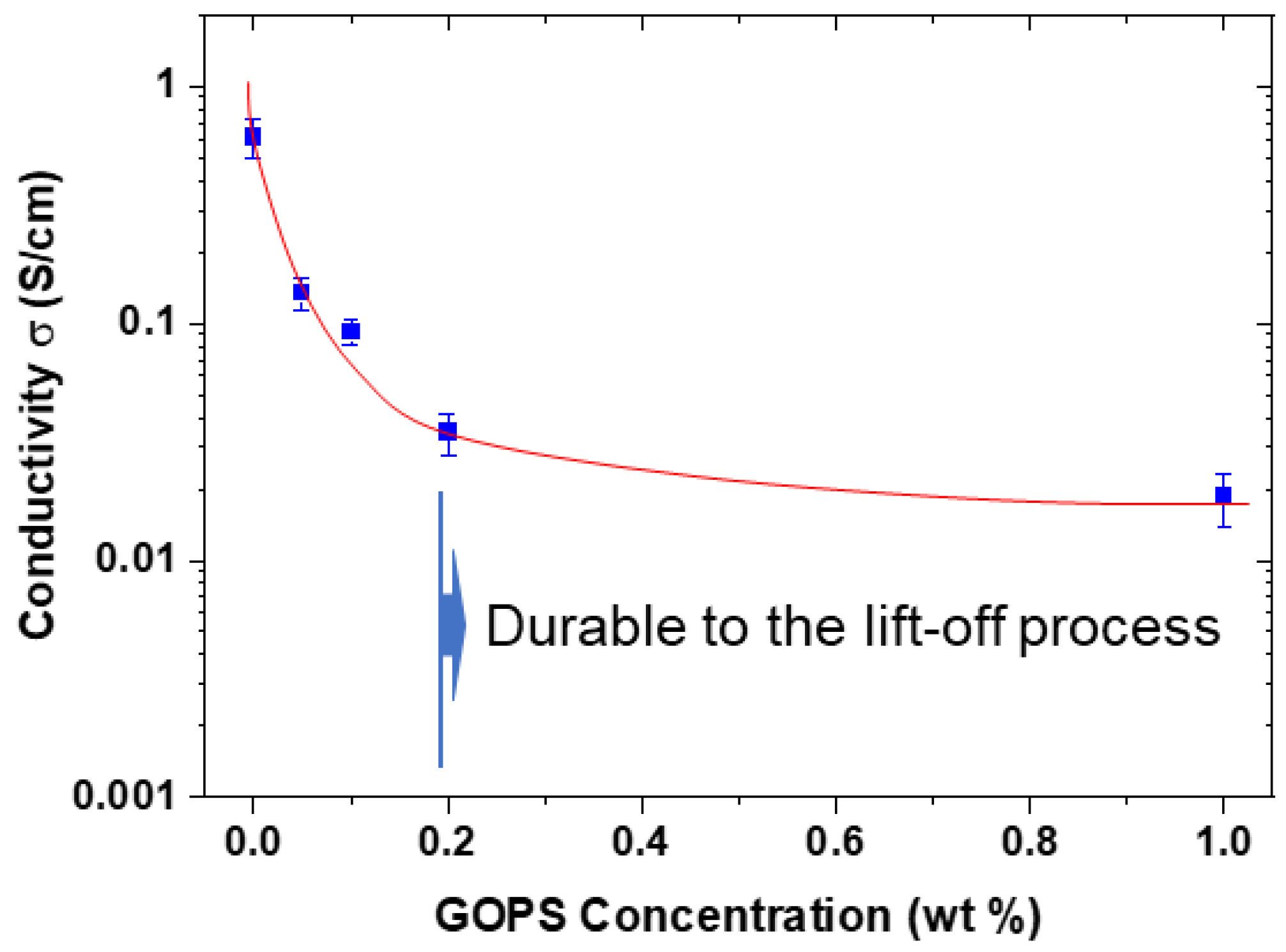


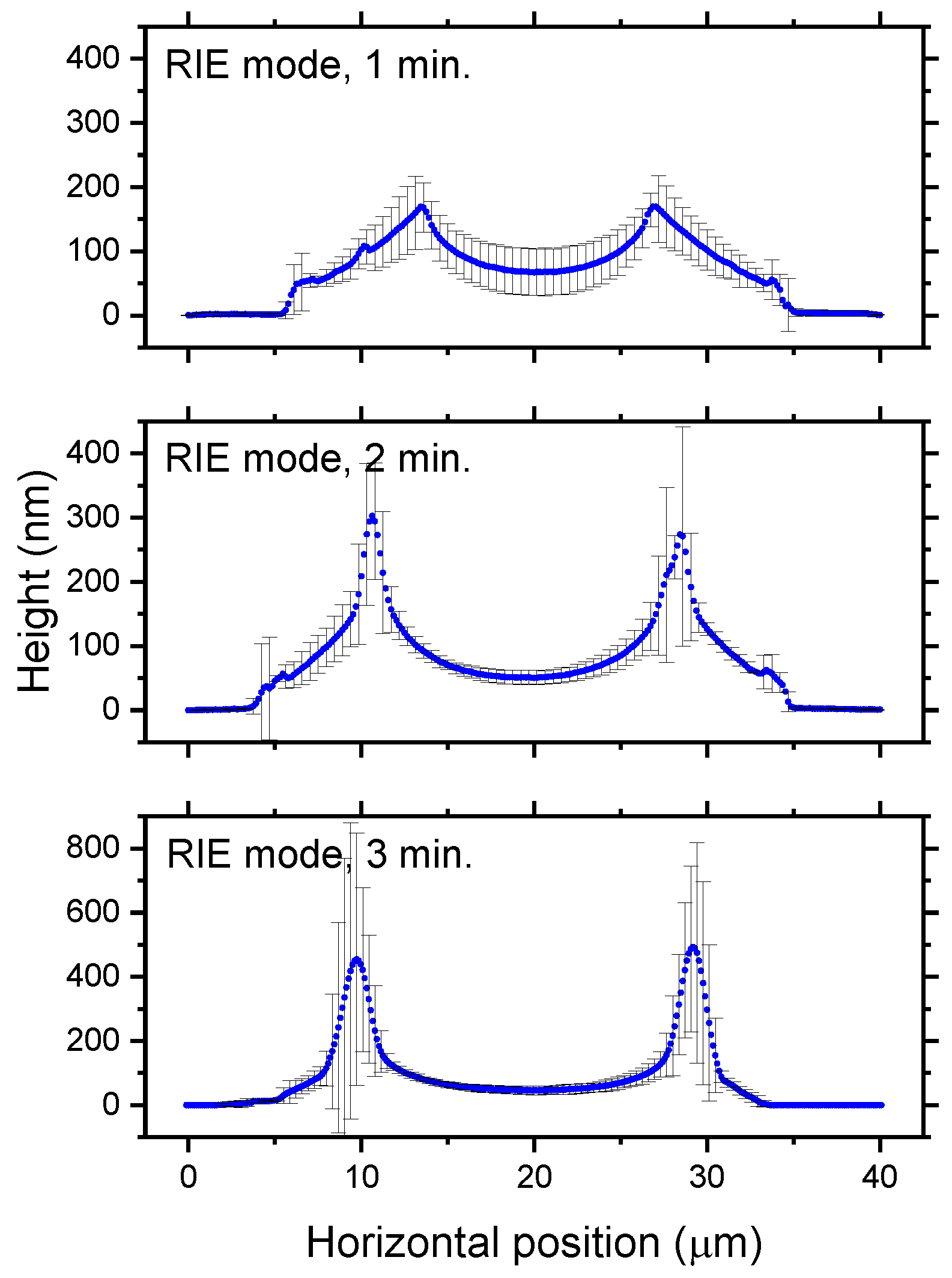
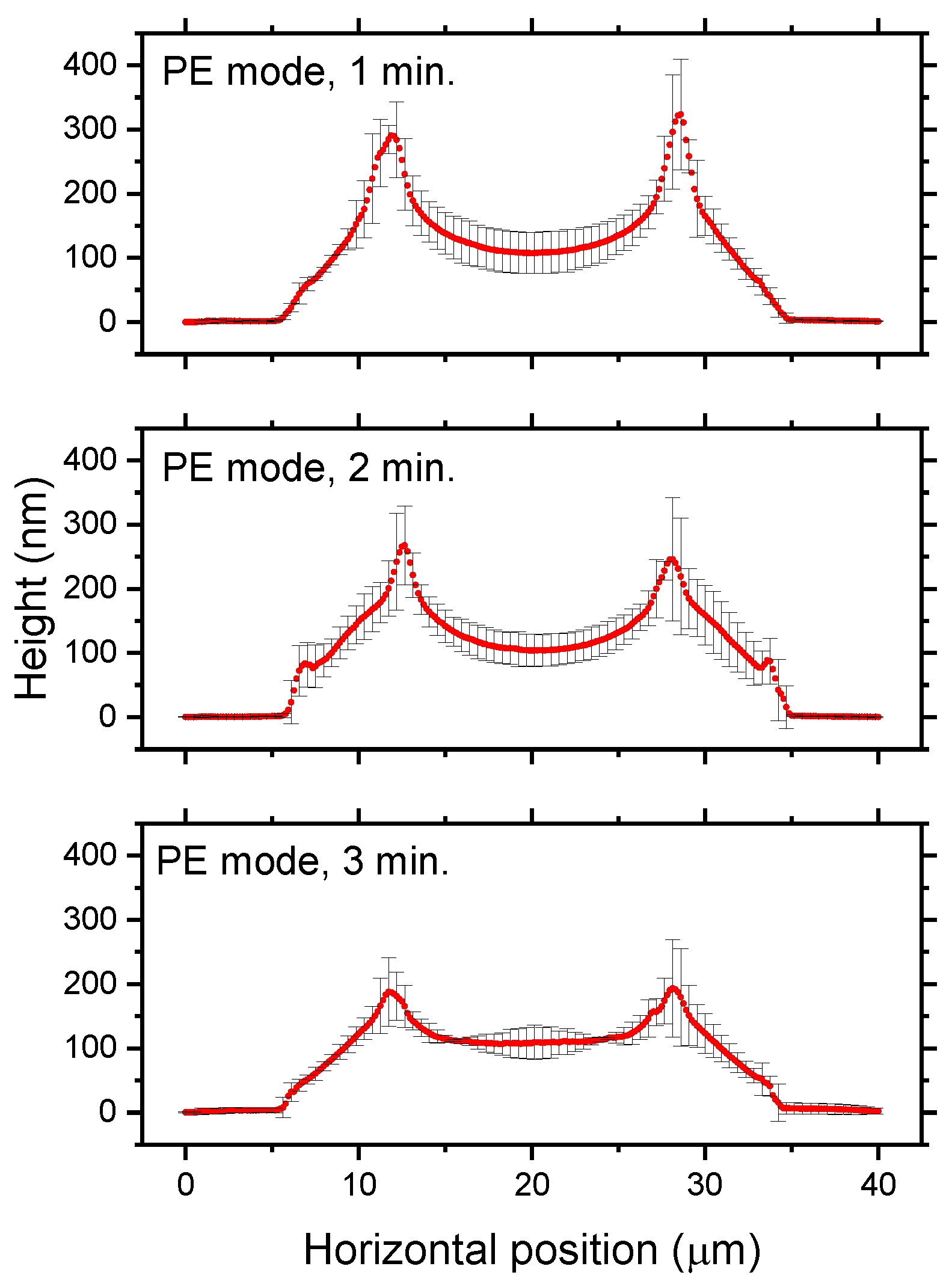
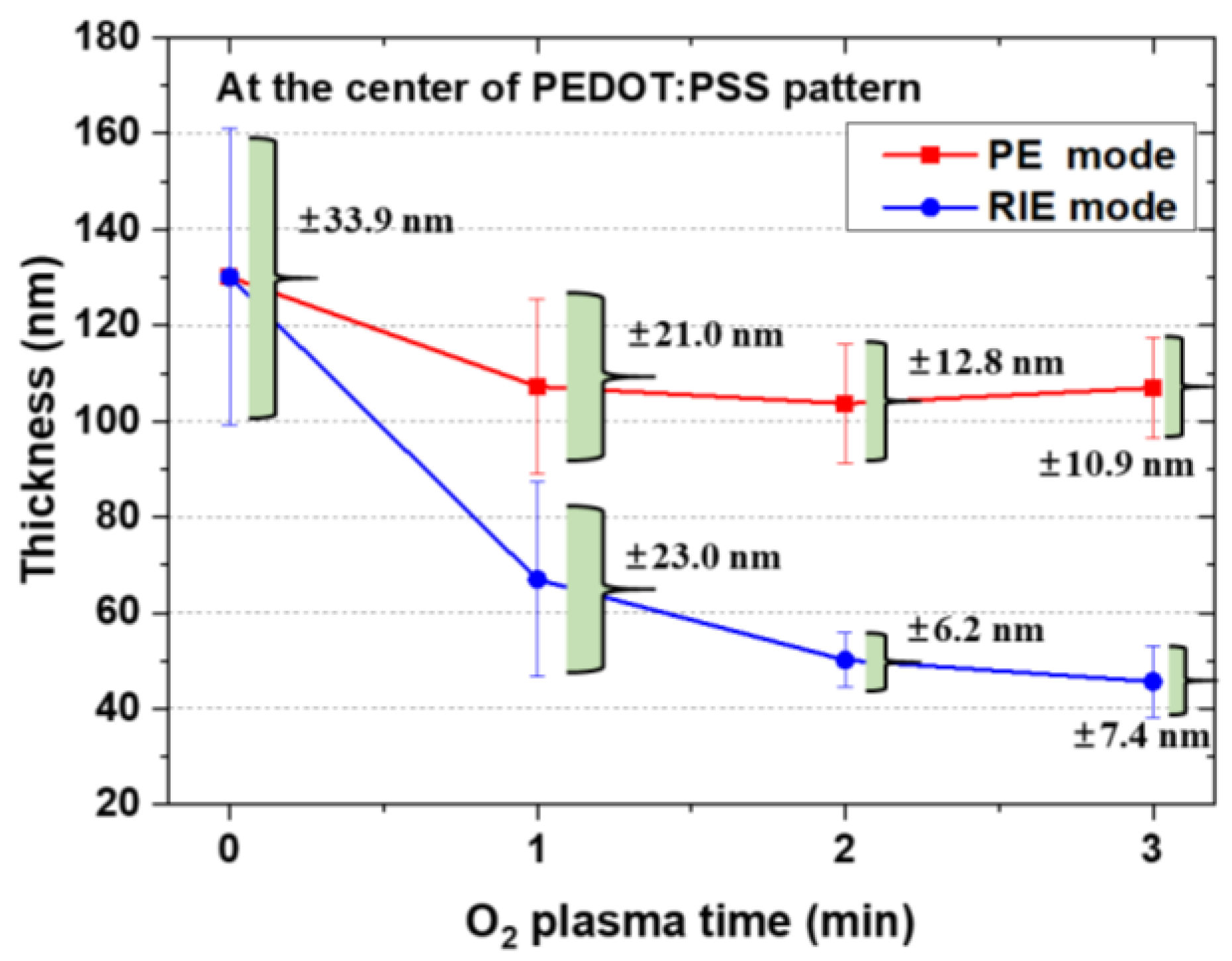

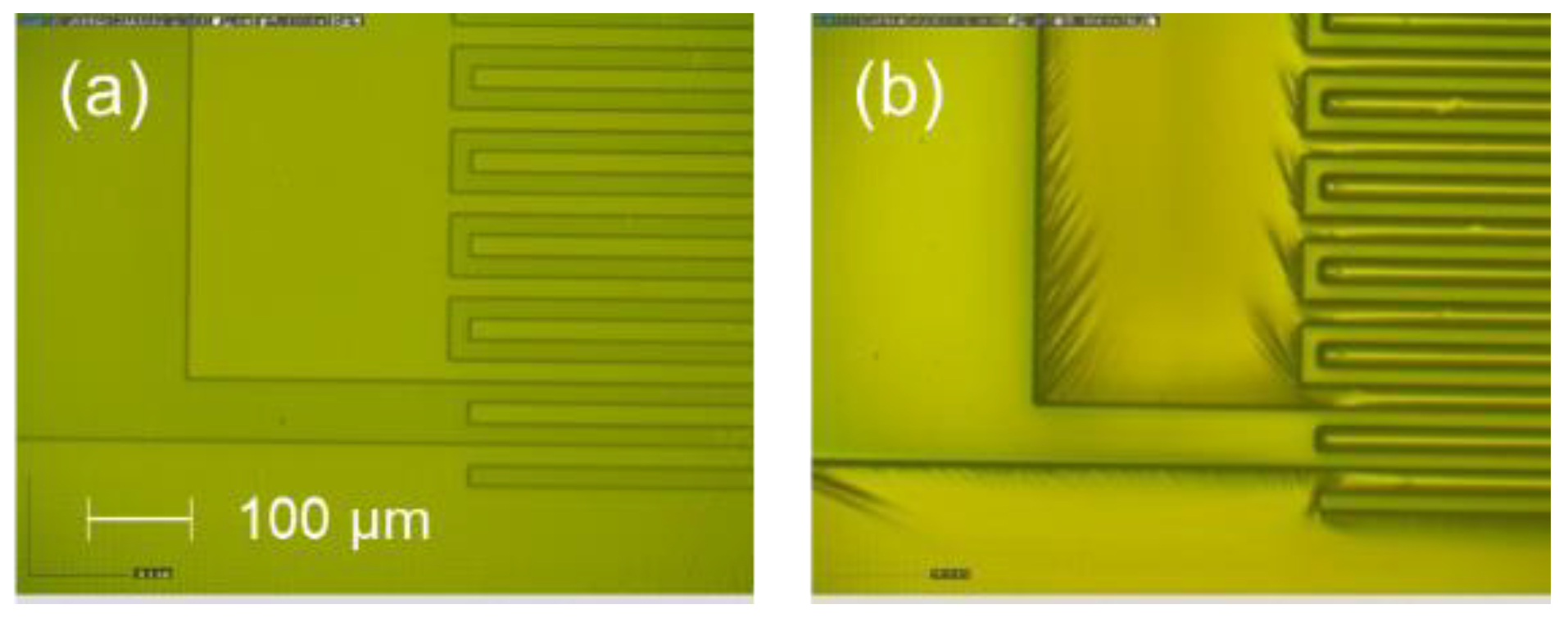
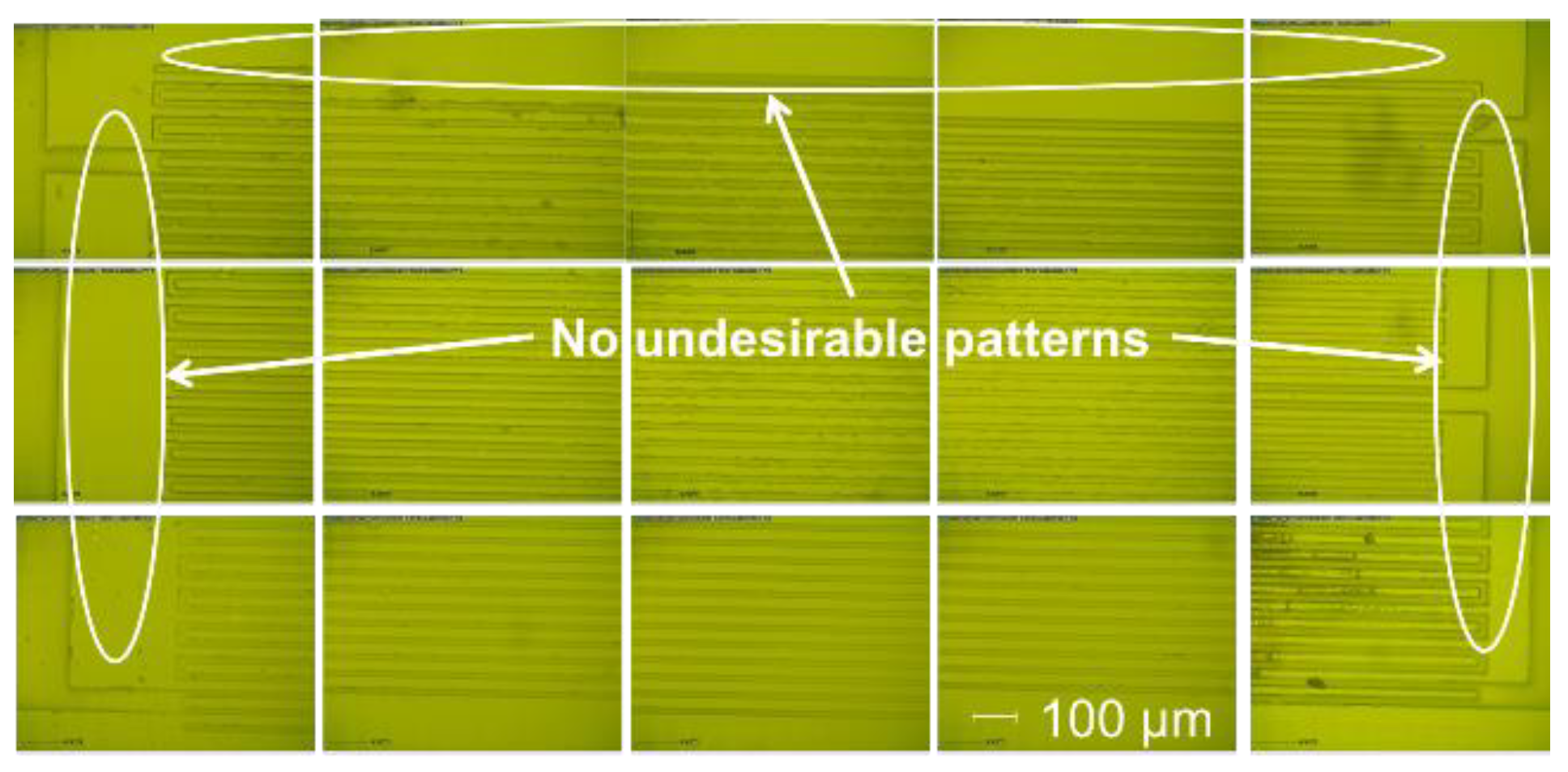
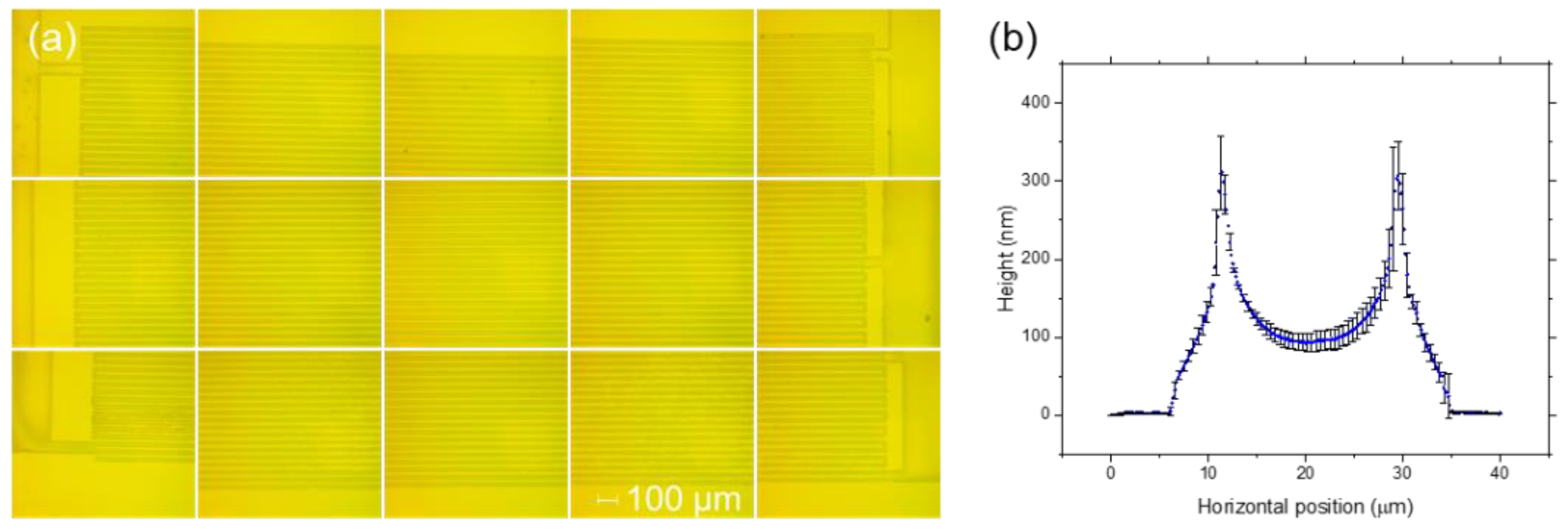
Publisher’s Note: MDPI stays neutral with regard to jurisdictional claims in published maps and institutional affiliations. |
© 2020 by the authors. Licensee MDPI, Basel, Switzerland. This article is an open access article distributed under the terms and conditions of the Creative Commons Attribution (CC BY) license (http://creativecommons.org/licenses/by/4.0/).
Share and Cite
Zheng, D.-Y.; Chang, M.-H.; Pan, C.-L.; Oh-e, M. Effects of O2 Plasma Treatments on the Photolithographic Patterning of PEDOT:PSS. Coatings 2021, 11, 31. https://doi.org/10.3390/coatings11010031
Zheng D-Y, Chang M-H, Pan C-L, Oh-e M. Effects of O2 Plasma Treatments on the Photolithographic Patterning of PEDOT:PSS. Coatings. 2021; 11(1):31. https://doi.org/10.3390/coatings11010031
Chicago/Turabian StyleZheng, Deng-Yun, Meng-Hsiang Chang, Ci-Ling Pan, and Masahito Oh-e. 2021. "Effects of O2 Plasma Treatments on the Photolithographic Patterning of PEDOT:PSS" Coatings 11, no. 1: 31. https://doi.org/10.3390/coatings11010031






